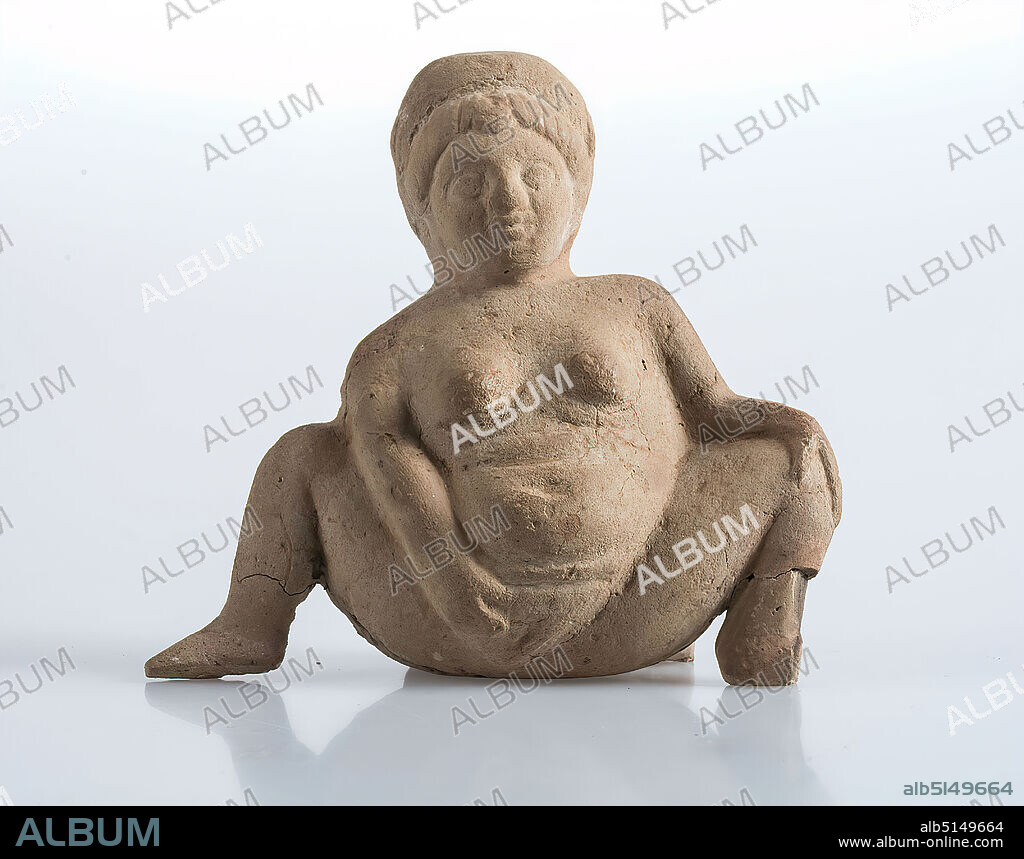alb5149664
Baubo, clay, hand-modeled, fired (ceramic), clay, Total: Height: 9.5 cm; Width: 10.3 cm; Depth: 5 cm, ceramic, nude, nude, nude, unclothed, (almost) nude, female nude, squatting, stooped figure, delivery, birth, Hellenism, The small, plump and nude female figure has her legs spread to the side in birthing posture, the feet put on, grasps the shame with her right hand. The left hand is placed on the knee. On the head she wears a wreath. Figures of this motif are called Baubo (Greek: lap). Because of the thick belly and the unusual sitting posture with exposed shame, one assumes that she is depicted as a woman giving birth. While the left hand rests on the thigh, the right hand helps itself to bring the child into the world. This curious representation is generally understood as a symbol of fertility, or more precisely as a reference to the ability to bear children. Presumably the ominous statuette was given to women giving birth to protect the mother and the unborn child. The figure belongs to the group of the so-called Fayum terracottas. In Alexandria, the international, Greek-influenced center of Egypt, lives a multicultural society of Egyptians, Orientals, Greeks, Romans, Jews and others, whose different religious ideas are gradually blending together. Insights into this world of faith are provided by the so-called Fayum terracottas. They are part of the religious household, children's toys, knick-knacks, but also cult symbols, grave goods, pilgrimage images, votive offerings and magical objects for banishing evil forces. They can be found in houses, graves and sanctuaries.

|
Zu einem anderen Lightbox hinzufügen |
|
Zu einem anderen Lightbox hinzufügen |



Haben Sie bereits ein Konto? Anmelden
Sie haben kein Konto? Registrieren
Dieses Bild kaufen.
Nutzung auswählen:

Untertitel:
Siehe automatische Übersetzung
Baubo, clay, hand-modeled, fired (ceramic), clay, Total: Height: 9.5 cm; Width: 10.3 cm; Depth: 5 cm, ceramic, nude, nude, nude, unclothed, (almost) nude, female nude, squatting, stooped figure, delivery, birth, Hellenism, The small, plump and nude female figure has her legs spread to the side in birthing posture, the feet put on, grasps the shame with her right hand. The left hand is placed on the knee. On the head she wears a wreath. Figures of this motif are called Baubo (Greek: lap). Because of the thick belly and the unusual sitting posture with exposed shame, one assumes that she is depicted as a woman giving birth. While the left hand rests on the thigh, the right hand helps itself to bring the child into the world. This curious representation is generally understood as a symbol of fertility, or more precisely as a reference to the ability to bear children. Presumably the ominous statuette was given to women giving birth to protect the mother and the unborn child. The figure belongs to the group of the so-called Fayum terracottas. In Alexandria, the international, Greek-influenced center of Egypt, lives a multicultural society of Egyptians, Orientals, Greeks, Romans, Jews and others, whose different religious ideas are gradually blending together. Insights into this world of faith are provided by the so-called Fayum terracottas. They are part of the religious household, children's toys, knick-knacks, but also cult symbols, grave goods, pilgrimage images, votive offerings and magical objects for banishing evil forces. They can be found in houses, graves and sanctuaries.
Persönlichkeiten:
Bildnachweis:
Album / quintlox
Freigaben (Releases):
Model: Nein - Eigentum: Nein
Rechtefragen?
Rechtefragen?
Bildgröße:
4320 x 3402 px | 42.0 MB
Druckgröße:
36.6 x 28.8 cm | 14.4 x 11.3 in (300 dpi)
Schlüsselwörter:
AEGYPTEN • AKT (MALEREI) • AKT, WEIBLICH • DEKORATION • ENTBLÖSSUNG • ENTBLÖßT • FREIMAURER: SYMBOLE • FRUCHTBARKEIT • GLAUBE • GRIECHE • GRIECHIN • GRIECHISCH • GRUPPE • HAUS • HELLENISTISCH • HÄUSER • INTERNATIONAL • JUDE • JUDEN • JUEDISCH • KERAMIK • KOPF (ANATOMIE) • KOPF • MUTTER • NACKT (NACKTHEIT) • NACKT • NIPPES • OBERSCHENKEL • ORNAMENT • ORNAMENTE • STEINGUT • SYMBOL • TOEPFEREI • TOEPFERWARE • TON • TUMBAS • TÖPFEREI • VERZIEHRUNG • VERZIERUNG • VOLLSCHLANK • WEIBLICHER AKT • WELT • ZIERDE • ÄGYPTEN
 Pinterest
Pinterest Twitter
Twitter Facebook
Facebook Link kopieren
Link kopieren Email
Email
